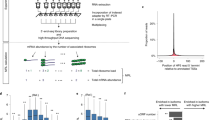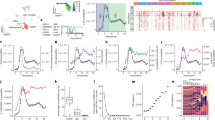Abstract
HIAP2 is a multifunctional protein that is critically involved in the regulation of cell survival and apoptosis. Here, we show that HIAP2 5′ untranslated region functions as a strong inhibitor of translation. Sequence analysis of human, mouse and rat sequences revealed that there exists a short open reading frame (ORF) that is located just upstream of the HIAP2 coding sequence. The translation of this uORF severely inhibited translation of the downstream reporter gene in vivo but not in vitro. Point mutation that destroys the CUG initiating codon of uORF markedly enhanced translation of the reporter gene without affecting the mRNA levels. Our results identify a novel translational regulatory mechanism that controls the expression of HIAP2 and point to the importance of tight regulation of antiapoptotic gene expression.
Similar content being viewed by others
Log in or create a free account to read this content
Gain free access to this article, as well as selected content from this journal and more on nature.com
or
Abbreviations
- UTR:
-
untranslated region
- IAP:
-
inhibitor of apoptosis protein
- TNF:
-
tumour necrosis factor
- BIR:
-
baculoviral IAP repeat
- RING:
-
really interesting new gene
- IRES:
-
internal ribosome entry site
- CAT:
-
chloramphenicol acetyltransferase
- βgal:
-
β-galactosidase
- ELISA:
-
enzyme-linked immunosorbent assay
- RPA:
-
ribonuclease protection assay
- ONPG:
-
o-nitrophenyl-β-D-galactopyranoside
References
Reed JC . (1999) Dysregulation of apoptosis in cancer. J. Clin. Oncol. 17: 2941
Holcik M, Gibson H and Korneluk RG . (2001) XIAP: apoptotic brake and promising therapeutic target. Apoptosis 6: 253–261
Holcik M and Korneluk RG . (2001) XIAP, the guardian angel. Nat. Rev. Mol. Cell. Biol. 2: 550–556
Salvesen GS and Duckett CS . (2002) Apoptosis: IAP proteins: blocking the road to death's door. Nat. Rev. Mol. Cell Biol. 3: 401–410
Rothe M, Pan MG, Henzel WJ, Ayres TM and Goeddel DV . (1995) The TNFR2-TRAF signaling complex contains two novel proteins related to baculoviral inhibitor of apoptosis proteins. Cell 83: 1243–1252
Ekert PG, Silke J and Vaux DL . (1999) Caspase inhibitors. Cell Death Differ. 6: 1081–1086
Li X, Yang Y and Ashwell JD . (2002) TNF-RII and c-IAP1 mediate ubiquitination and degradation of TRAF2. Nature 416: 345–347
Clem RJ, Sheu TT, Richter BW, He WW, Thornberry NA, Duckett CS and Hardwick JM . (2001) c-IAP1 is cleaved by caspases to produce a proapoptotic C-terminal fragment. J. Biol. Chem. 276: 7602–7608
Chu ZL, McKinsey TA, Liu L, Gentry JJ, Malim MH and Ballard DW . (1997) Suppression of tumor necrosis factor-induced cell death by inhibitor of apoptosis c-IAP2 is under NF-kappaB control. Proc. Natl. Acad. Sci. USA 94: 10057–10062
Holcik M, Lefebvre CA, Yeh C, Chow T and Korneluk RG . (1999) A new internal-ribosome-entry-site motif potentiates XIAP-mediated cytoprotection. Nat Cell Biol 1: 190–192
Young SS, Liston P, Xuan JY, McRoberts C, Lefebvre CA and Korneluk RG . (1999) Genomic organization and physical map of the human inhibitors of apoptosis: HIAP1 and HIAP2. Mamm. Genome. 10: 44–48
Imoto I, Yang ZQ, Pimkhaokham A, Tsuda H, Shimada Y, Imamura M, Ohki M and Inazawa J . (2001) Identification of cIAP1 as a candidate target gene within an amplicon at 11q22 in esophageal squamous cell carcinomas. Cancer Res. 61: 6629–6634
Imoto I, Tsuda H, Hirasawa A, Miura M, Sakamoto M, Hirohashi S and Inazawa J . (2002) Expression of cIAP1, a target for 11q22 amplification, correlates with resistance of cervical cancers to radiotherapy. Cancer Res. 62: 4860–4866
Tamm I, Kornblau SM, Segall H, Krajewski S, Welsh K, Kitada S, Scudiero DA, Tudor G, Qui YH, Monks A, Andreeff M and Reed JC . (2000) Expression and prognostic significance of IAP-family genes in human cancers and myeloid leukemias. Clin. Cancer Res. 6: 1796–1803
Liston P, Lefebvre C, Fong WG, Xuan JY and Korneluk RG . (1997) Genomic characterization of the mouse inhibitor of apoptosis protein-1 and 2 genes. Genomics 46: 495–503
Holcik M, Lefebvre CA, Hicks K and Korneluk RG . (2002) Cloning and characterization of the rat homologues of the inhibitor of apoptosis protein 1, 2, and 3 genes. BMC Genomics 3: 5–10
Geballe AP . (1996) Translational control mediated by upstream AUG codons. In Translational Control, Hershey JWB, Mathews MB, Sonenberg N, eds (Cold Spring Harbor: Cold Spring Harbor Press) pp. 173–197
Nanbru C, Lafon I, Audigier S, Gensac MC, Vagner S, Huez G and Prats AC . (1997) Alternative translation of the proto-oncogene c-myc by an internal ribosome entry site. J. Biol. Chem. 272: 32061–32066
Vagner S, Gensac MC, Maret A, Bayard F, Amalric F, Prats H and Prats AC . (1995) Alternative translation of human fibroblast growth factor 2 mRNA occurs by internal entry of ribosomes. Mol. Cell. Biol. 15: 35–44
Nevins TA, Harder ZM, Korneluk RG and Holcik M . (2003) Distinct regulation of internal ribosome entry site-mediated translation following cellular stress is mediated by apoptotic fragments of eIF4G translation initiation factor family members eIF4GI, p97/DAP5/NAT1. J. Biol. Chem. 278: 3572–3579
Holcik M, Yeh C, Korneluk RG and Chow T . (2000) Translational upregulation of X-linked inhibitor of apoptosis (XIAP) increases resistance to radiation induced cell death. Oncogene 19: 4174–4177
Harigai M, Miyashita T, Hanada M and Reed JC . (1996) A cis-acting element in the BCL-2 gene controls expression through translational mechanisms. Oncogene 12: 1369–1374
MacGregor GR, Nolan GP, Fiering S, Roederer M and Herzenberg LA . (1991) Use of E. coli lacZ (β-galactosidase) as a reporter gene. In Methods in Molecular Biology, Murray EJ, Walker JM, eds (Clifton, NJ: Humana Press Inc.) pp. 217–235
Acknowledgements
We thank the members of our laboratory for stimulating discussions, Jaime Blais for the help with the MACS-VA500 microaerophilic workstation and the University of California San Francisco/Neurosurgery Tissue Bank for the SF-268 cell line. This work was supported by the operating grant from the Canadian Institutes of Health Research (# 43984). MH is a CIHR New Investigator.
Author information
Authors and Affiliations
Corresponding author
Additional information
Edited by G Salvesen
Rights and permissions
About this article
Cite this article
Warnakulasuriyarachchi, D., Ungureanu, N. & Holčík, M. The translation of an antiapoptotic protein HIAP2 is regulated by an upstream open reading frame. Cell Death Differ 10, 899–904 (2003). https://doi.org/10.1038/sj.cdd.4401256
Received:
Revised:
Accepted:
Published:
Issue date:
DOI: https://doi.org/10.1038/sj.cdd.4401256
Keywords
This article is cited by
-
Multiple mechanisms repress N-Bak mRNA translation in the healthy and apoptotic neurons
Cell Death & Disease (2013)
-
Distinct roles for the cellular inhibitors of apoptosis proteins 1 and 2
Cell Death & Disease (2011)
-
hnRNP A1 regulates UV-induced NF-κB signalling through destabilization of cIAP1 mRNA
Cell Death & Differentiation (2009)
-
A mutation in an alternative untranslated exon of hexokinase 1 associated with Hereditary Motor and Sensory Neuropathy – Russe (HMSNR)
European Journal of Human Genetics (2009)
-
Translational control in stress and apoptosis
Nature Reviews Molecular Cell Biology (2005)



